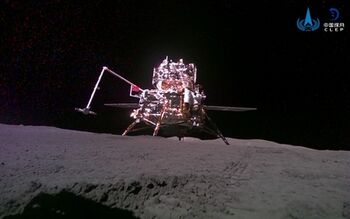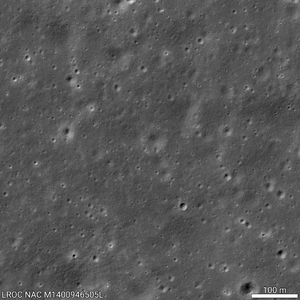Chang'e 6 facts for kids

The Chang'e 6 lander (with the ascender on top) on the far side of the Moon. The photo was taken from a mobile camera that was released from the lander
|
|
| Mission type | Surface sample return |
|---|---|
| Operator | CNSA |
| Mission duration | 52 days, 20 hours and 39 minutes |
| Spacecraft properties | |
| Manufacturer | CAST |
| Launch mass | 8,350 kg (18,410 lb) |
| Start of mission | |
| Launch date | 3 May 2024 09:27:29 UTC |
| Rocket | Long March 5 |
| Launch site | Wenchang |
| End of mission | |
| Landing date | 25 June 2024 06:07 UTC Return capsule |
| Landing site | Inner Mongolia, China |
| Lunar orbiter | |
| Orbital insertion | 8 May 2024 02:12 UTC |
| Orbital departure | 20 June 2024 ~15:00 UTC |
| Orbit parameters | |
| Periapsis | 220 km (140 mi) |
| Inclination | 137° |
| Lunar lander | |
| Landing date | 1 June 2024 22:23:16 UTC |
| Return launch | 3 June 2024 23:38:10 UTC |
| Landing site | Southern mare of Apollo Basin 41°38′19″S 153°59′07″W / 41.6385°S 153.9852°W |
| Lunar rover | |
| Landing date | 1 June 2024 22:23:16 UTC |
| Landing site | Southern mare of Apollo Basin |
| Docking with Sample Ascender | |
| Docking date | 6 June 2024 06:48 UTC |
| Undocking date | 6 June 2024 |
|
Chinese Lunar Exploration Program
|
|
Chang'e 6 (Chinese: 嫦娥六号; pinyin: Cháng'é liùhào) was a special robotic mission to the Moon by China. It was part of the Chinese Lunar Exploration Program. The spacecraft is named after Chang'e, a Chinese goddess of the Moon.
The mission started on May 3, 2024, when the probe launched from China's Hainan island. Its lander and a small camera rover landed on the far side of the Moon on June 1, 2024. This was a big deal because it was the first time a country collected samples from the Moon's far side. The lander used a robotic scoop and drill to gather samples. These samples were then put into an "ascender" module. This module launched into lunar orbit on June 3, 2024.
The ascender then connected with the orbiter module in space on June 6, 2024. The samples were moved to a special return capsule on the orbiter. This capsule brought the samples back to Earth. The lander and mini-rover also did science experiments on the Moon's surface. The whole mission lasted about 53 days, ending on June 25, 2024.
Contents
What is the Chinese Lunar Program?
The Chinese Lunar Exploration Program is a plan to explore the Moon step-by-step. It has four main phases:
- The first phase was about reaching the Moon's orbit. Chang'e 1 (2007) and Chang'e 2 (2010) completed this.
- The second phase aimed to land and drive a rover on the Moon. Chang'e 3 (2013) and Chang'e 4 (2019) did this.
- The third phase involves collecting Moon samples and bringing them back to Earth. Chang'e 5 (2020) did this first, and Chang'e 6 continued this important work.
- The fourth phase plans to build a robotic research station near the Moon's south pole. China also hopes to send people to the Moon in the 2030s. They might even build a human outpost there.
The previous mission, Chang'e 5, brought back about 1.731 kg of material. Those samples came from the northern part of the Moon's near side.
Why is the far side important?
The Chang'e 6 mission landed on the southern part of the Moon's far side. It went to a flat area inside the Apollo crater. This crater is part of the huge South Pole–Aitken basin. Scientists hope the samples from this area might include material from deep inside the Moon, called the lunar mantle. This material could help us understand why the Moon's near side and far side are different. It could also teach us more about how the Moon and our Solar System formed.
The Chang'e 6 lander touched down at 22:23 UTC on June 1, 2024. It landed in the southern part of the Apollo Basin. After collecting samples, the ascender took off from the lander at 23:38 UTC on June 3, 2024. The ascender then connected with the Chang'e 6 orbiter in lunar orbit. This happened at 06:48 UTC on June 6, 2024. The Moon samples were safely moved to the Earth return module shortly after. Finally, on June 25, 2024, the return capsule landed successfully in Inner Mongolia, China.
The mission's lander collected about 2 kg of material from the Moon's far side. This included soil and rocks from the surface and deeper underground. If the mission is fully successful, China will be the first nation to bring back samples from the Moon's far side.
The hole left by the sampling looked like the Chinese character zhong (中). This character is the first part of China's name, Zhōngguó 中国. Many people on Weibo thought this was very cool!
How Chang'e 6 was built
Chang'e 6 was built very much like Chang'e 5. It had four main parts, or modules:
- Lander: This part landed on the Moon. It had a drill and a scoop to collect samples. The Ascender sat on top of the Lander. It gathered about 2 kg of samples, some from 2 meters below the surface. These samples were then put into the Ascender.
- Ascender: This part launched from the Moon's surface into orbit. It then flew itself to meet and connect with the Orbiter. The samples were robotically moved into a special capsule for their trip back to Earth.
- Orbiter: After getting the samples from the Ascender, the Orbiter left the Moon's orbit. It flew back towards Earth for about 4.5 days. Just before reaching Earth, it released the Returner.
- Returner: This was the capsule that brought the samples back. It used a special "skip reentry" method to bounce off Earth's atmosphere once before coming all the way down.
Science tools on board
Chang'e 6 carried special science tools from different countries. In 2018, China invited international partners to add their own instruments. Here are some of them:
On the Lander
- DORN (Detection of Outgassing Radon) from France: This tool studied how lunar dust and other gases move between the Moon's surface and its thin atmosphere. It also looked at the water cycle.
- INRRI (INstrument for landing-Roving laser Retroreflector Investigations) from Italy: This is a special mirror that helps measure distances very accurately from the lander to orbit.
- NILS (Negative Ions on Lunar Surface) from Sweden: This instrument detected and measured tiny charged particles called negative ions that bounce off the Moon's surface.
On the Orbiter
- The Pakistani ICUBE-Q CubeSat: This small satellite was built by the Institute of Space Technology and Shanghai Jiao Tong University. It had two cameras to take pictures of the Moon's surface. It also collected data about the Moon's magnetic field.
On the Rover
Chang'e-6 also carried a small, unannounced mini-rover. It was called a Mobile Camera. This rover was expected to help study what the Moon's surface is made of. It also looked for water ice in the lunar soil and took pictures of the Chang'e 6 lander.
Mission journey
Launch

The Chang'e 6 probe launched on a Long March 5 rocket. This happened at 09:27 UTC on May 3, 2024. The launch site was the Wenchang Satellite Launch Center on Hainan Island.
Travel to the Moon
After launching, Chang'e 6 successfully entered orbit around the Moon. This happened at 02:12 UTC on May 8, 2024. The lander, ascender, and rover then separated from the orbiter and returner on May 30, 2024. This was to get ready for landing.
Landing on the Moon
At 22:06 UTC on June 1, 2024, the Chang'e 6 lander and ascender began their descent. They were helped by the Queqiao-2 satellite. The lander used its smart systems to avoid obstacles and find a safe spot. It landed successfully at 22:23 UTC in the South Pole–Aitken basin on the Moon's far side. The engine turned off for the final part of the landing, and a cushioning system helped it touch down softly.
Journey back to Earth
At 23:38 UTC on June 3, 2024, the Chang'e 6 ascender, carrying the Moon samples, took off from the far side of the Moon. It entered orbit around the Moon. This was the first time samples were collected and launched from the Moon's far side!
At 06:48 UTC on June 6, 2024, the ascender met and connected with the orbiter and returner in lunar orbit. By 07:24 UTC, the Moon sample container was safely moved into the returner.
On June 21, 2024, the Chang'e 6 service module likely fired its engines to begin its journey back to Earth. Finally, on June 25, 2024, at 06:07 UTC, the return capsule landed successfully in Siziwang Banner, Inner Mongolia.
See also
 In Spanish: Chang'e 6 para niños
In Spanish: Chang'e 6 para niños
- Lunar resources
- Lunar water
- VIPER (rover)
- Luna 27
- LUPEX


